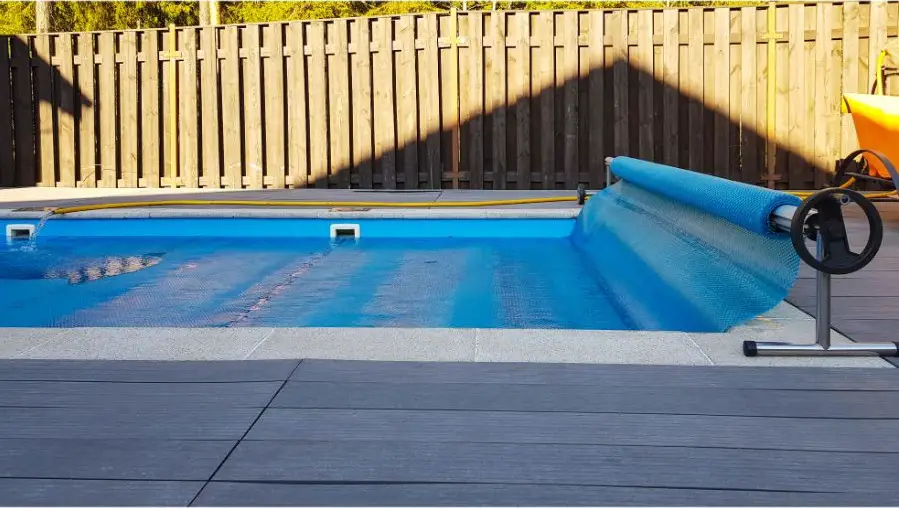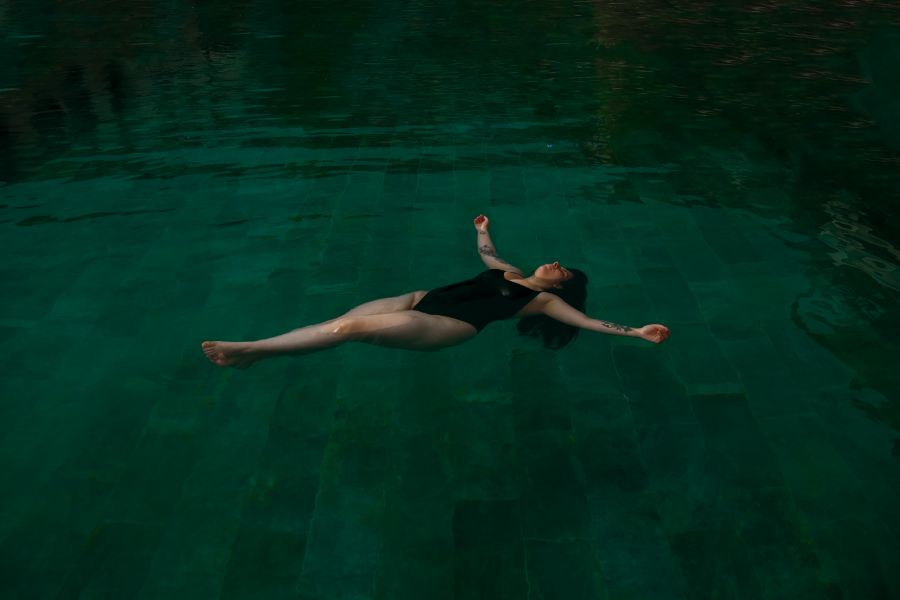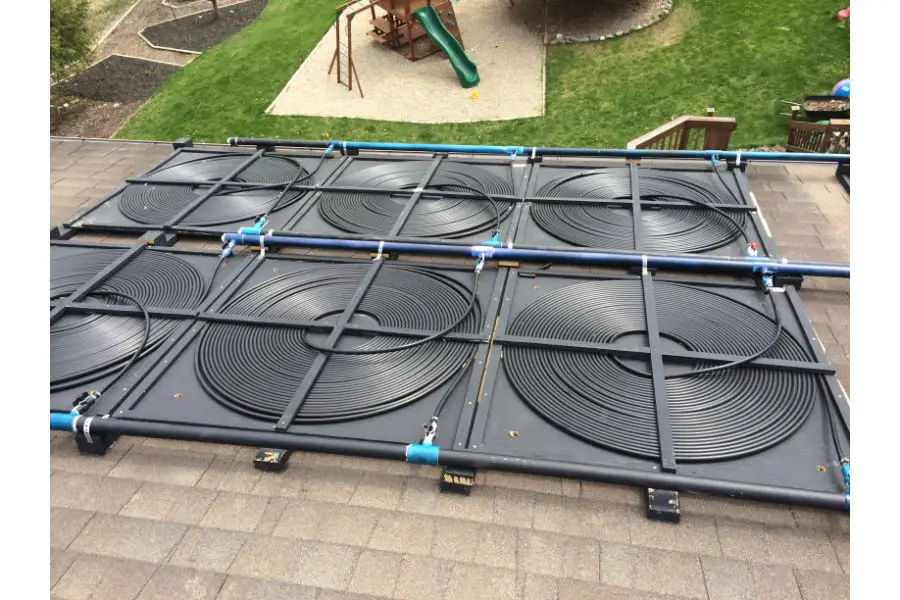Your pool’s temperature plays a key role in just how much enjoyment you and your guests will have in the water.
When the temperature is right, diving into the pool can be one of the most refreshing experiences on a summer day. When the temperature is too cold, it can result in more people staring at the water versus actually being in the water.
The perfect water temperature will vary based on personal preference, but in general 84 to 90°F will satisfy most.
Some pool owners rely on a traditional gas or electric heater to keep the water warm. However, these heaters can be costly with both the initial cost and also the recurring monthly energy bills.
Fortunately, for those of us who don’t have a pool heater or would like to save on utility costs, there are alternative means to heat a swimming pool for free.
This article will explore how to heat a pool without a heater using 9 different methods. Many of these options will give you opportunity to heat your pool for free without purchasing anything!
Most of these tips can be used to heat both above-ground and in-ground pools. What’s even more, you may be able to combine these methods in order to maximize heating without a traditional heater.
Without further ado, here’s how to heat up a pool fast without a heater:
1 – Solar Blanket

If you’re trying to heat a pool without a heater, a solar blanket should be one of your top considerations. It has the ability to increase your pool temperature by 10 – 15°F depending on how much sunlight it receives.
The blanket is typically sized to fit the area and shape of the pool in order to rest on the surface of the water. Costs of solar blankets typically range from $50 to $300 depending on size and thickness (mil).
Most blankets have one side that contains small air-filled bubbles (like bubble wrap) that are placed face down into the water. The bubbles help capture the sun’s rays and transfer the resulting heat into the water.
While the blanket can help add heat to the pool on sunny days, it has an even more critical function: preventing evaporation. Evaporation is one of the quickest ways to lose that heat you’ve been trying to build up in the water –every ¼ inch of water that evaporates can cause the pool temperature to drop by 5°F
A properly fit solar blanket can reduce evaporation by 95%. It’s particularly useful when the temperature is cool outside or when it’s windy.
You’ve probably seen a layer of fog rolling off the pool on a cool morning –this is pretty much a visual of your heat escaping! Even pool owners that have a standard heater often use a blanket to help retain heat, as that fog is essentially money floating away.
One of the most common complaints with solar blankets is that they can be a hassle to put on and take off. A solar reel can help alleviate this problem and is highly recommended –they’re available for both in-ground and above ground pools!
Another downfall of solar blankets is that they do not tend to last more than a couple of pool seasons due to exposure to the sun and pool chemicals. Often, the bubbles will start to fall apart leaving small bits of plastic in your pool.
You can also consider a cheap DIY solar cover if the price tag on the bubble cover seems steep.
2 – Solar Rings
Solar rings are similar in concept to a solar blanket in that they sit on the water surface to help transfer the sun’s energy into the water while also preventing evaporation.
As the name implies, solar rings are typically in the shape of a circle –but, you may find some in other shapes, such as hexagons.
The rings can come in various sizes with five feet diameter being most common. Depending on the size of your pool it may take anywhere from 4 to 30 rings to sufficiently cover the surface.
The rings often have magnets around the edges to help them connect to adjacent rings, but some rings may use velcro instead.
In comparison to a solar blanket, the rings do not provide as much coverage of the pool due to gaps between the rings. This means that they won’t be as efficient in preventing evaporation (heat loss).
Solar rings are generally composed of UV-resistant vinyl which allows them to last up to several years before potentially requiring replacement.
The rings can have a relatively high initial cost, especially if needing to cover a large pool. They can also be prone to blowing away in windy areas, which may limit their areas of use.
If trying to decide between solar rings or a solar cover, you can checkout a detailed comparison here to help you determine which is better.
If you’re looking to minimize the cost, there are DIY solar rings that can be made using black trash bags with pool noodles (or hula hoops) as a frame. They may not have all the bells and whistles –such as magnets– like commercial ones, but they’re worth keeping in mind as a cheap alternative.
3 – Liquid Solar Cover
If you’d rather not deal with having to place a blanket or rings on your pool –but still want to keep it warm without a heater– then a liquid solar cover is worth checking out.
To apply the liquid cover, simply pour the appropriate quantity from the bottle into the pool. The amount to add will depend on how large the surface area of your pool is.
There are several patented types of liquid solar covers on the market, but they all have similar premise. They use a combination of alcohols along with a dispersant –such as calcium hydroxide– that ensures the blanket covers the entire surface.
The liquid cover forms a small micro-layer across the top of the water which helps prevent evaporation in order to retain heat. Sunlight can continue to shine directly into the water to allow for heating.
The primary benefit of a liquid solar cover is that you do not need to deal with pulling a traditional cover on and off. The liquid cover is non-toxic and is safe for swimmers to hop right in –no one will even know it’s there!
Swimming in the pool will only briefly disrupt the cover as it will quickly re-establish itself on the surface after the waves calm.
To keep the liquid cover effective, you’ll just need to add some more periodically –often once a week– based on the instructions.
The liquid solar cover can reduce evaporation by up to 40%. It becomes less effective in windy conditions as ripples in the water will disrupt the cover.
While the liquid solar cover may not retain as much heat in your pool as a solid blanket or solar rings, it can make up for it with its ease of use!
4 – Remove Shade
While shade has its place around the yard, most would agree that they’d rather be swimming in sunshine rather than shade.
Keeping the pool exposed to direct sunlight is a great way to use the sun as your pool heater. The rays from the sun heat the pool’s structure, which then transfers the heat into the water.
Direct sunlight on the pool during the peak of the day can heat the water up to 1°F per hour. If the pool is receiving shade for a portion of the day the amount of heating will be reduced.
While removing shade may be easier said than done, it may be worth the consideration in certain situations.
If you have an above ground pool that sits in the shadow of the house for much of the day, it could be worth considering moving the pool into a sunnier spot. For in-ground pools that are in a similar situation, there’s not much you’ll be able to do to eliminate the shade.
If you have large trees that are hovering around the pool, they may be casting shade on your pool. While tree removal could be a consideration, even a good trimming may be enough to allow more sun exposure to the pool.
5 – Block the Wind
While cool air temperatures can cause evaporation of your pool, so can the wind. As the wind blows across the surface of the pool it will hasten the rate of evaporation, which will cause the water temperature to drop.
The faster the wind speed, the greater the rate of evaporation. While a solar blanket can reduce most of the evaporation caused by wind, the blanket can’t be used while swimming.
Particularly if you live in an area that tends to be windy, it may be worth looking to add a wind barrier as a means to retain your pool heat.
Fences are generally required to surround pools for safety reasons, in which the right style of fence could actually serve as a wind break also. Tall privacy fences around the pool are a great way to block the wind.
Strategically planted shrubbery and trees can also block the wind. Just remember that tall trees might cast shadows on the pool which might prevent the sun from heating the water as much.
6 – Paint the Pool

Many concrete pools are painted a bright ocean blue color. While this color is visually pleasing, it won’t necessarily promote heating.
Using a darker paint color for the pool should be a consideration if trying to improve heating without a traditional heater. Dark surfaces are better at absorbing the sun’s heat than light colored surfaces –hence why wearing dark clothing outside in the sun can make you feel like a walking oven.
For those looking to fully maximize the sun’s potential, a black painted pool will absorb the most heat. While black pools have started to become more trendy recently, the thought of a black pool may be visually off-putting for many owners.
Even if a black pool is out of the question, other darker paint colors –such as a royal blue– can capture more heat from the sun than a light blue.
Aside from improved heating, a darker color can also help hide some of the dirt that would more likely stick out in a lighter pool –this could be a good or bad thing, depending on who you ask!
Next time your pool is due for re-painting, it may be worth entertaining the idea of a darker color if trying to improve your heating.
7 – Reduce Water Features
A fountain or waterfall has the ability to take your pool to the next level. Unfortunately, for those trying to heat the pool these features can result in cooling the water.
Water features that have any sort of spraying or splashing will increase the rate of evaporation. This evaporation will result in heat loss.
That’s not to say that water features should be avoided solely to help heat your pool. These features have benefits to them, such as providing that feel of luxury and also improving water circulation.
Your pool will continue heating through the sun’s rays, but its heating efficiency may be slightly reduced by the water features.
To maximize your pool heating, you should consider controlling the water features with a timer. Having the features shut off automatically at night will stop them from continuing to cool the pool.
8 – Turn Off the Pool Pump at Night
A pump is an essential part of the pool system. It circulates water throughout the pool and filter in order to keep it clean.
In order to keep the pool clean, it’s recommended that your pump runs long enough to achieve at least one complete water turnover each day. In other words, if your pool holds 20,000 gallons, you’ll want to run the pump long enough to circulate 20,000 gallons of water each day.
Depending on the volume of your pool and the size of your pump, it may be necessary to run the pump upwards of 12 hours a day.
Running the pump increases the amount of heat transfer between the air and water as it circulates through the pool. If the pump is running at night when temperatures are cooler, heat will exit the water quicker especially if not using a solar cover.
It may be surprising, but using a pool noodle is a simple way to figure out how long your pump should run.
Once you’ve determined how long your pump needs to run to maintain appropriate cleanliness of the water, you can determine at what point into the evening the pump can be shut off.
A pool timer is a great way to keep your pump on a daily schedule, and can help you avoid accidentally running it overnight.
9 – Angle the Pool Jets
Pool return jets are an important part of your pool’s circulation system that may be often overlooked.
The jets move the water throughout the pool to create even mixing of water that has been returned from the filter. This mixing promotes even temperature throughout the water to avoid warm or cold spots.
Most pool jets have eyeballs that can be angled to shoot water in the desired direction. Although it may seem that the eyeballs can be oriented in any direction, there are certain techniques recommended.
While pointing the eyeballs upwards can create a nice eruption of water coming from the pool’s surface, this can also have a cooling effect on the pool. Similar to a water fountain, water bubbling out of the water from a return jet will be more prone to evaporation and cooling.
To promote better heating and circulation of your pool, direct the eyeballs slightly downward so that the water is not rising from the surface. Directing the eyeballs in the same direction is also recommended in order to maintain efficient turnover of water.
Bonus: Solar Heating System

Since this article is focused on providing options to heat your pool without a heater, we’re not going to necessarily count this next one as part of our list –but, we’re still going to look at it: Solar Heating System.
If your primary goal is to heat your pool without a traditional gas or electric heater, then a solar heating system is definitely worth considering.
Solar heating systems can usually increase the temperature 10 – 12°F above that of an unheated pool. Couple the solar heating system with a cover, and it’s possible to keep the pool in the upper 80’s throughout much of the swim season even in the northern climates.
There are different styles of pool solar heating systems available on the market, with the most common using flat collectors. The flat collectors are a series of small black tubes that water from the pool flows through while absorbing the sun’s energy for heating.
Oftentimes the solar heater can be run through your pool pump and filtration system, but sometimes a booster pump is needed to achieve optimal flow. A booster pump will result in some electric usage (along with a higher utility bill!).
The size of your pool will dictate how large of a solar heating system you need. It’s generally recommended that the solar heater surface area is between 50 – 100% of your pool’s surface area.
For many medium to large sized pools, the size of the solar heater panels requires a vast open space, such as a roof. Orientation of the panels is also important, with south-facing being the optimal.
Commercial solar panels are generally considered to be most efficient due to the design of the tubing systems. However, even a DIY solar heater also can provide noticeable heating benefit to the pool.
As with most heating options, the ultimate cost will depend on the size of the solar heating system required for your pool. Generally, you can expect an initial cost of $2,500 to $4,000.
In comparison to the energy costs for a gas or electric heater, solar heaters can often pay for themselves within several years.
Final Takeaway
These 9 methods are prime examples of how to heat your pool without a heater. Many can be used in combination with each other to boost your pool’s temperature even quicker.
In most cases, you’ll be best served by harvesting the sun’s energy. The sun provides free energy that won’t send you a bill at the end of the month unlike when you use a gas or electric heater.
To take your heating to the next level it’s important to eliminate evaporation whenever possible. Less evaporation means that your pool will retain heat better, allowing the pool temperature to incrementally rise as the days go by.
Not all of these heating methods will work for everyone, but there should be at least a few that can improve your pool heating without a heater.
Happy (Warm) Swimming!
Husband and father of three (actually, four if you include the pool). I’m an avid DIY-er and weekend warrior that enjoys taking up new projects around the house to help us maximize leisure right at home. I enjoy researching and sharing various tips, tricks and knowledge to help others make their home an oasis.

